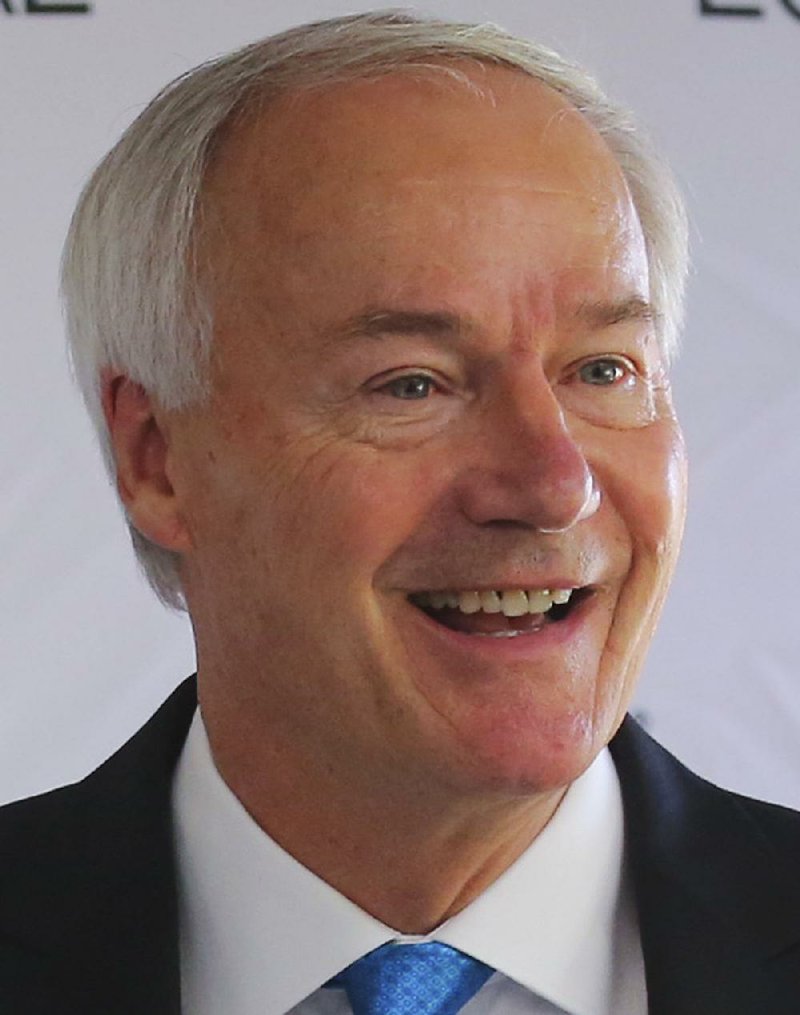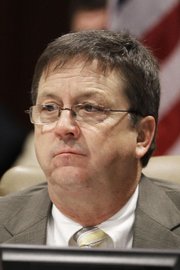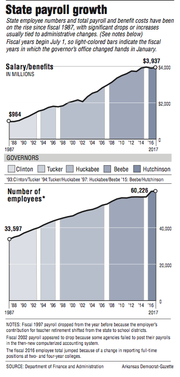The number of full-time state employees increased by 297 to 60,226 last fiscal year, and their ranks at public colleges and universities increased but numbers at other agencies declined, according to an annual state report.
At the end of fiscal 2017 on June 30, full-time workers at two-year and four-year public colleges and universities increased by 345, compared with the end of fiscal 2016, to 28,764. At other state agencies, full-time employees declined by 48, to 31,462, during this period, Arkansas Department of Finance and Administration records show.
Many state employees are under the control of Republican Gov. Asa Hutchinson, but some work for the other six constitutional officers, such as secretary of state and attorney general; the Legislature; the courts; higher-education institutions; and the agencies run by the constitutionally separate entities, the Game and Fish Commission and the Highway Commission.
"My goal has been to transform state government by continuing important public services, but to do so in a more efficient and cost effective way," Hutchinson said in a written statement in response to questions about the state payroll.
Hutchinson assumed office in January 2015, midway through fiscal 2015. He has been the state's chief executive for two full fiscal years -- 2016 and 2017.
When the governor took office, he signed an executive order requiring agencies under his control to get his approval to fill vacant positions.
The order "has been used as a tool to control unnecessary growth," the governor said.
The number of full-time employees in agencies under his control remained constant last fiscal year with an increase of only one full-time employee, "despite the necessity to add child welfare workers, parole officers, and corrections employees," the governor said. "These additions were the result of public safety requirements and legislative direction. Even though these areas required more state employees, there were reductions in other areas of state government that resulted in almost no growth in total numbers."
The report on full-time employees provides a broad snapshot of state government operations, but periodically, errors creep in and the numbers have to be revised.
For example, the finance department reported that the University of Arkansas at Pine Bluff's full-time employee total increased to 692. The finance department's figures are based on agency reports to the Bureau of Legislative Research. The bureau calculates quarterly averages for full-time employees.
Eight days after the Arkansas Democrat-Gazette asked about UAPB's figures, Janet Broiles, chief of staff at UAPB, said Thursday night that the university's human-resources office submitted revised numbers to the bureau and "the actual number of positions should have been 621, not 692."
Tara Smith, deputy director at the state Department of Higher Education, said late Friday afternoon that the number of full-time employees at state colleges last fiscal year is expected to be reduced soon, after the bureau reviews UAPB's revised numbers and enters them into its system.
HIGHER PAYROLL
More state employees means more spending. In fiscal 2017, state employees' salary and benefit costs increased by $33 million, or 0.85 percent, over the previous fiscal year to $3.93 billion, records indicate.
The salary and benefit costs at public colleges and universities increased from $1.98 billion in fiscal 2016 to $2.11 billion in fiscal 2017, while the costs at other agencies declined from $1.91 billion in fiscal 2016 to $1.82 billion in fiscal 2017, according to Department of Finance and Administration spokesman Scott Hardin.
Regarding the growth in full-time employees in higher education, Hutchinson said he's encouraged those institutions to operate more efficiently.
"Higher ed is, of course, independent of the direct supervision of the executive branch," the governor said. Amendment 33 to the Arkansas Constitution grants some independence to the boards of trustees of state colleges and universities. Trustees are appointed by the governor as openings occur.
"I recognize that each agency or institution of higher education faces its own challenges. And when an agency must add staff to meet its mission, then they are authorized to go ahead and fill the additional positions. A good example would be filling jobs in our Department of Correction. While we are obviously emphasizing efficiencies and trying to shrink the size of state government, we recognize that there are limits to doing so and that the vital role of some agencies may at time require additional positions," Hutchinson said in his statement.
Republicans have controlled the Legislature since 2013, for the first time since Reconstruction.
Hutchinson has tried fairly hard to hold down the growth of state employees and he's done a good job at that, said Sen. Larry Teague, D-Nashville, who is a co-chairman of the Legislature's Joint Budget Committee.
"Overall, I think we are in pretty good shape," he said.
But Sen. Bryan King, R-Green Forest -- a critic of Hutchinson -- said that "we are way too bloated" and blames fellow Republicans.
"We could easier cut 15 $100,000 administrators" and save $1.5 million, he said. He said agencies such as the Department of Agriculture and the Board of Election Commissioners could eliminate administrative positions.
Comparing last fiscal year's growth in employees to the 2,966-employee increase in fiscal 2016 isn't meaningful, Hardin said. That's because the fiscal 2016 growth was largely because of a law that expanded the positions the higher-education institutions are required to report. That change in the law helped increase by 3,290 the number of full-time employees reported at two-year and four-year colleges. Employees at other agencies declined by 324 in fiscal 2016.
Discounting fiscal 2016, growth in numbers of full-time state employees generally has slowed since fiscal 2010.
HIGHER EDUCATION
Full-time employees increased by 455 to 25,182 at four-year colleges and universities last fiscal year. Their ranks dipped by 134 to 2,521 at two-year colleges and increased by 24 to 1,061 at technical colleges.
Enrollment at two-year and four-year colleges slipped from 150,043 in the fall of 2015 to 148,991 in the fall of 2016, according to the Department of Higher Education. Enrollment at four-year universities increased from 99,519 to 100,859 during this period, while enrollment at two-year colleges declined from 50,524 to 48,132.
Maria Markham, higher-education director, said colleges and universities are mindful of balancing student and patient needs with expenditures for employees.
The growth in fiscal 2017 "was largely driven by expansions" at the University of Arkansas for Medical Sciences, she said.
"Faculty and resident physicians, as well as research positions, at UAMS accounted for roughly half of the new positions statewide," Markham said.
UAMS' full-time employees increased by 511 to 10,389, state records show.
Much of the growth at that university "has been in our clinical enterprise and has been driven by patient demand," said UAMS spokesman Leslie Taylor. "All of these new clinics, units and areas have required that we not only hire more physicians, nurses, physician assistants, pharmacists and other health care professionals, but also administrative and support staff."
Employees at the University of Arkansas, Fayetteville, rose by 109 to 4,118.
"The primary reason for the increase in full-time employees relates to growth in the number of students attending the University of Arkansas, the University's commitment to increase the success and support of our students, and an increase in externally supported research activity at the U of A," said Steve Voorhies, a UA spokesman.
"Out of our total head count increase of 109 employees, 75 of them are in faculty or graduate assistant positions with the remainder in various administrative positions including advising, student support, and in our Student Affairs area," Voorhies said.
Employees increased by 46 to 1,783 at the University of Central Arkansas in Conway and by 37 to 1,687 at Arkansas State University in Jonesboro, according to state records.
The numbers dropped by 61 to 639 at the University of Arkansas' Agricultural Experiment Station; by 47 to 594 at the UA Cooperative Extension Service; and by 43 to 1,224 at the University of Arkansas at Little Rock, state records show.
UA Agriculture Division spokesman Mary Hightower said staff declines in the experiment station and Cooperative Extension Service are based mainly on "decades of flat funding eroded by inflation and unfunded mandates, coupled with fluctuations in the number of seasonal workers, graduate assistants, and jobs supported by finite research and educational grants.
"Further declines in employee numbers are inevitable without a permanent increase in base funding -- requests not filled in the last two legislative sessions," Hightower said.
At UALR, "our employee numbers have been trending slightly downward over the past couple of years. This is part of an effort by the university to trim costs to align with budget and keep our expenses in line with enrollment," said UALR spokesman Judy Williams.
EXECUTIVE BRANCH
Executive branch agencies ended fiscal 2017 with 25,615 full-time employees -- one more than the previous year. At the Department of Finance and Administration, which compiled the annual report, ranks dropped by 14 to 2,532.
But at the Department of Human Services, the number increased by 219 to 7,516.
"Overall, the bulk of our increase is related to the Division of Children and Family Services and the Division of Developmental Disability Services," said Amy Webb, a department spokesman.
The governor and the Legislature provided funding for more caseworkers, support staff and supervisors because "of the significant growth of the number of children in foster care and because of the extraordinarily high caseloads our staff was carrying," she said. "Hiring and training is ongoing, but caseloads are down and we believe the infusion of staff has made a positive difference for our existing workers and the children and families we serve."
At the Developmental Disabilities Services Division, "we have put a great deal of effort into hiring and retaining direct care staff at our five human development centers," Webb said. "People sometimes forget that DHS is not just an agency with people in offices -- about half of our employees work in direct care settings. Those positions can have high turnover rates.
"The pay plan increases [effective in July] have certainly helped, but we've also hired more direct care staff to cut down on the overtime that we were spending and to make the work more manageable for staff. Investing in additional hires is important for the quality of life of both our staff and the clients they work with every day," she said.
Meanwhile, full-time employees at the Department of Health slipped by 233 to 2,018.
The "bulk of those would have been attributable to the transfer of our in-home services division to the private sector," said Robert Brech, the Health Department's general counsel.
Full-time employees increased by 50 to 1,316 at Arkansas Community Correction, while they dropped by 63 to 4,075 at the Department of Correction.
Arkansas Community Correction was allowed 65 more positions at the start of fiscal 2016, and "these positions were phased in over a two-year period ... and were comprised of mostly parole/probation Officers with a few assistant area managers and treatment positions," said agency spokesman Dina Tyler. "The intent of the additional positions were to reduce caseloads to a more manageable ratio."
The Department of Correction's decline in filled positions resulted from "routine position turnover" and the department surrendering 100 filled positions, said department spokesman Solomon Graves.
At the Department of Veteran Affairs, full-time employees increased by 39 to 171. The majority of the increase is from the opening of the veterans home in North Little Rock and "we will continue to grow as we continue to open more cottages in the facility," said department spokesman Sarah Jones.
Hutchinson said his 2015 executive order requiring his approval to fill vacancies "was effective in reducing the number of positions, but it placed a significant bureaucratic burden on our agencies.
"We've since sent a memo to our agencies laying out a significant change," he said. "Each of the agencies has been asked to lay out a personnel plan for the next year. That plan should include any changes to the mission of the agency which might require additional staffing or allow for reductions.
"As part of that plan, we are also working with our agencies to establish caps for the number of employees and the total base salary for the agency," Hutchinson said. "We have not yet completed the right sizing of state government and future staff levels will depend upon the needs of the state along with the transformation efforts that will continue."
INDEPENDENT AGENCIES
The Department of Transportation's full-time employees declined by 42 to 3,690, while those at the Game and Fish Commission rose by seven to 575.
Department of Transportation spokesman Danny Straessle said the numbers are "just a reflection of normal turnover, retirements, etc." The agency is overseen by the Highway Commission.
The Judicial Disability and Disability Commission gained one employee and reported having six.
JUDICIAL BRANCH
The Supreme Court held steady at 64. The Court of Appeals had full-time 49 employees, a gain of one.
The Administrative Office of the Courts gained nine employees and reported 378. The increase resulted from the office assuming responsibility for paying juvenile drug court coordinators previously paid by the state auditor, said Sam Kauffman of the court office.
CONSTITUTIONAL OFFICES
The governor's office gained two full-time employees, to 56, while Governor's Mansion employees stayed at nine. The governor's office staff has dropped to 53 with staff departures, said spokesman J.R. Davis.
"The number of employees in the governor's office varies from time to time based upon a number of factors including whether there is a legislative session or other special needs," Hutchinson said.
Among five of the other constitutional officers, all Republicans:
• Lt. Gov. Tim Griffin held steady with two employees.
• Attorney General Leslie Rutledge's office ranks dipped by six to 165.
• Treasurer Dennis Milligan saw his office's employees slip by three to 30.
• Secretary of State Mark Martin's ranks dropped by one to 139.
• Land Commissioner John Thurston's staff remained at 40.
Changes reflect turnover, according to spokesmen for these offices.
The seventh constitutional officer is Auditor Andrea Lea. The number of full-time employees for whom Lea's office is the disbursing officer dipped by nine to 269. The reduction is from the transfer of responsibility for paying juvenile drug court coordinators to the Administrative Office of the Courts, said Lea spokesman Skot Covert.
Covert said auditor employees totaled 27, an increase of one, as a result of filling vacancies.
LEGISLATIVE BRANCH
Full-time employees working for four legislative branch agencies declined by five to 429. Arkansas Legislative Audit dipped by three to 278 and the Bureau of Legislative Research employees declined by two to 112. The staff count remained at 25 for the House of Representatives and 14 for the Senate.
SundayMonday on 09/03/2017



